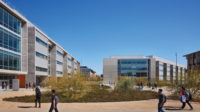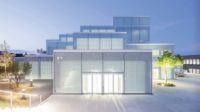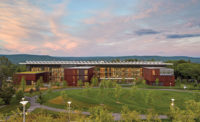Plans proceed apace at Harvard, Columbia, Penn, Yale, and Princeton.
During the last 10 years or so, five leading American universities have produced large-scale plans to guide their expansion, all of which are currently in various stages of implementation. The realization of these proposals will add millions of square feet of academic and related space to the campuses and cost billions of dollars. At the same time, higher education online is increasing in popularity, paradoxically offering the possibility of reduced demand for teaching space as well as lower education costs for students. Because of new online capabilities, could the expansion of the physical campus at these elite institutions soon be outdated?
To be sure, much of the physical expansion revolves around specialized research facilities–since research, in addition to teaching, forms such a vital component of the university mission. Even so, the 2008 economic crisis delayed fulfillment of some of these schemes; the recession caused Harvard University, for example, to revise its ambitious development for the Boston neighborhood of Allston, located across the Charles River from the Cambridge campus. The plan, prepared by Cooper, Robertson & Partners, Gehry Partners, and the Olin Partnership, called for the addition of up to 10 million square feet of academic and student-life space over 50 years. In 2009, construction of a $1.4 billion science center designed by Behnisch Architekten was stopped after its foundations had been completed. The university is reprogramming the science building, now called the Health and Life Science Center, and has yet to say whether it is hiring a new architect. Harvard is also seeking partnerships with third-party developers for a biomedical-research campus along with residential and retail spaces on this site.
Columbia University's expansion into New York's Manhattanville neighborhood seems less affected by the recession. After years of assembling properties and obtaining regulatory approvals, the university is moving ahead with its plan, prepared by Renzo Piano Building Workshop with Skidmore, Owings & Merrill. When completed, the 17-acre site, nine blocks north of Columbia's Morningside Heights campus in West Harlem, will total almost 7 million square feet. The first phase of the new campus, now under construction, includes the 450,000-square-foot Jerome L. Greene Science Center, designed by Piano, to be followed by two new buildings for the Columbia Business School by Diller Scofidio + Renfro.
Another plan going forward is for the University of Pennsylvania in Philadelphia. In 2006, Penn issued a vision plan prepared by Sasaki Associates calling for infill expansion on the main campus as well as the redevelopment of 24 acres of land acquired from the U.S. Postal Service. The land, contiguous with the main campus, affords the university the opportunity to add athletic fields and expand the medical school and other facilities. Penn partnered with a private developer to finance the project, which also includes mixed-use (commercial and academic) space. The first phase, Penn Park, designed by Michael Van Valkenburgh, opened in 2011 and, in addition to athletic fields, offers green space accessible to the public. A center for nanotechnology research designed by Weiss/Manfredi, now under construction at 33rd and Walnut streets, will act as a new gateway to the university.
For its part, Yale University is engaging in a double-pronged expansion. In 2007, Yale bought a 136-acre site–formerly a corporate research-and-development park–along the Orange/West Haven border seven miles west of its New Haven campus. The existing plan and buildings are currently being kept and repurposed for biomedical and energy research, the School of Nursing, and museum storage and conservation. Yale is expanding not only in Connecticut but in Singapore as well. The only one of this group to build a campus abroad, the university is collaborating with the National University of Singapore to develop a 1,000-student undergraduate residential college. The new campus–for which KieranTimberlake and Pfeiffer Partners in collaboration with Forum Architects prepared the master plan, and Pelli Clarke Pelli with Forum Architects are the design architects–is expected to open in early 2015.
Unlike Yale, Princeton University is staying close to home. After considering an expansion of its substantial landholdings in neighboring townships, the university decided to augment development on its main campus. Nevertheless, Princeton hopes to maintain its open space by making use of peripheral sites where town and gown overlap. One such site centers on the terminus of a spur train where the university is creating an Arts and Transit Neighborhood to enable the addition of theater, dance, and music facilities while preserving commuter rail service. Beyer Blinder Belle has prepared the plan for the 22-acre site; Steven Holl Architects is designing the first phase of performing-arts buildings; and Rick Joy Architects is creating a new station building and renovating two early-20th-century station structures for a restaurant and café. The project is scheduled for completion in 2017.
As traditional universities expand their physical campuses, criticism is mounting that an undergraduate education at an elite college or university is accessible only to the “1 percent.” Yet it should be acknowledged that while costs continue to rise, only a small proportion of an undergraduate student's tuition at a well-endowed private university is typically allocated to the operations and maintenance of the physical plant. Construction of new buildings–especially for research–is supported primarily by donors and long-term financing.
Nevertheless, increased costs of education have prompted many universities to step up financial aid, as well as to offer their course materials online at no charge. In 2000, MIT launched its OpenCourseWare initiative. There are no “admission” requirements, but neither are there course credits or even certificates of completion. This effort has since evolved into a learning platform shared by Harvard and the University of California, Berkeley, called edX, which includes assessment, peer-to-peer learning, and live chats, among other networked features.
Coursera, another recently launched learning platform, offers online courses delivered by eminent faculty members from Princeton, Penn, Stanford University, and the University of Michigan, among others, and again, like edX, at no charge. Enrolled students, who do pay tuition and receive credit, take the course on campus, while many thousands of others registered with Coursera receive the same material online. At Princeton, faculty members are recording lectures in the Broadcast Center, a state-of-the-art facility originally built for connectivity with TV news stations. In the hybrid world of on- and off-campus learning, the video recording studio is emerging as a new type of teaching space, while the lecture hall may become obsolete.
While online learning on existing campuses is likely to require reconfiguration of academic space, most universities remain committed to the traditional emphasis on undergraduate residential life along with extracurricular activities, known since the 19th century as the “collegiate way.” This commitment to undergraduates, combined with university research–the primary impetus for creating new science, technology, engineering, and mathematics buildings–will most likely continue to promote expansion of the physical campus in the foreseeable future. So regarding the initial question about whether campus plans for these elite institutions may become outdated, the answer is probably not. Because of the traditional expectations about the academic community and the needs for research facilities, it looks as if virtual and physical worlds can successfully coexist.









Post a comment to this article
Report Abusive Comment